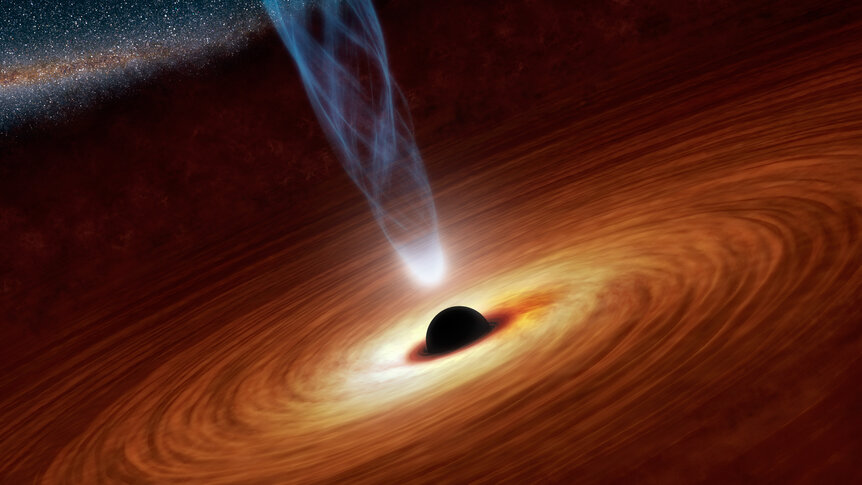Create a free profile to get unlimited access to exclusive videos, sweepstakes, and more!
In the distant Universe a supermassive black hole eats a sun *a day*

Astronomers have found the most massive known black hole in the very early Universe, and it’s a whopper: It has 34 billion — yes, billion, with a b — times the mass of the Sun.
And that’s only one part of this story that has the hair on the back of my neck standing up. Stick around for the rest. I promise, it’s hair-stand-uppable.
The black hole is in the center of an active galaxy called a quasar. These are where the central supermassive black hole (which every big galaxy has) is actively eating material. This stuff piles up into a disk around the black hole, swirling madly around it. Matter that's closer in moves very near the speed of light, and stuff farther out is slower, and as they rub together they generate friction, which heats the disk up a lot (imagine rubbing your hands together at the speed of light to see why). The temperature is so high, and there’s so much matter in the disk, that it glows incredibly brightly, in general outshining all the stars in the galaxy combined.
The quasar in question is called SMSS J215728.21–360215.1. Let’s call it J2157 for short. The astronomers found it looking at sky surveys for objects with the right colors to be very very far away active galaxies, and this one was found in the SkyMapper Southern Survey (hence the SMSS in the name; the rest is for its coordinates on the sky).
Once they determined it was likely to be a distant quasar, they observed it with the monster 10-meter Keck telescope in Hawaii and the 8-meter Very Large Telescope in Chile. By breaking the light up this way a lot of important information can be found, including how far away the quasar is, how bright it is overall, how massive that black hole is, and how much matter falls into it from the disk.
The quasar is crushingly far away: The light we see from it left it more than 12.5 billion years ago, just 1.25 billion years after the Big Bang itself. So we see this quasar as it was when it was very young.
The mass of the black hole is 34±6 billion times the mass of the Sun. For comparison, the supermassive black hole in the center of the Milky Way is about 4 million solar masses, so the one anchoring J2157 is over 8,000 times as massive.
!!!
There are whole galaxies with less mass than just this one black hole. It’s so big that if you replaced the Sun with it, it would encompass the entire solar system — it’s roughly 200 billion kilometers across. That’s… huge.
I’ll note that several more massive black holes have been found, but these are in galaxies closer to us than J2157. This one, though, is the most massive ever found at this distance range from us, at this early of a period in the Universe.
But we’re not done! Measuring the brightness of the object and knowing its distance allows the total energy emitted by the quasar to be found. It’s 1.6 x 1041 Joules/second. Are you sitting down for this next bit? That is one quadrillion times the amount of light the Sun emits.
One quadrillion. 1,000,000,000,000,000. Our entire Milky Way galaxy emits a fraction of a percent that much light. This makes J2157 the most luminous known quasar.
The physics is a bit complicated, but it’s also possible to estimate out how much matter is falling into the black hole to generate that much energy: It turns out to be about the mass of the Sun every day.
I ran the numbers and got the same answer. Even so it’s hard to grasp. In more local terms, that black hole is gobbling down the equivalent of the mass of the Earth four times per second.
Wow. Imagine tossing planets into a black hole that rapidly. That’s hundreds of thousands of times per day. Or, if you prefer, a hundred million times per year.
So, how’s that neck hair? Piloerected yet?
Everything about this object is overwhelming. But there’s real scientific value here. This being the biggest known black hole at this early an age in the Universe is a solid constraint on our understanding of how they grow. Did it get to this size by starting off big and eating rapidly, or starting off smaller and eating really rapidly? Did a bunch of smaller black holes form together and then merge to make its rapid growth? Is there some other weird thing going on here we haven’t thought of yet?
We know that the amount of light emitted by the disk increases with the mass of the black hole, and this one seems to fit that pattern. That means as weird as it is, it’s normal compared to other supermassive black holes, except for being even more supermassiver. That’s oddly reassuring, assuming you’re comfortable with supermassive black holes in the first place.
At this distance, it’s also telling us about conditions in the very early Universe, when galaxies were first getting started. We still don’t know a whole lot about this era, and every example we get is a piece of that puzzle we can examine.
In this case, a ridiculously massive, bright, and vastly gluttonous one.




























